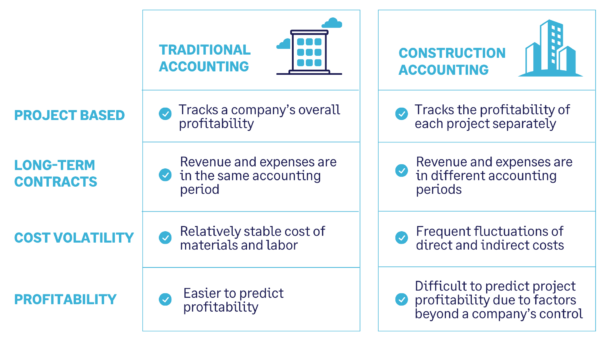A Comprehensive Guide to Building Accountancy: Enhance Your Financial Monitoring
Efficient financial administration is crucial in the building sector, where the complexities of project-based income and expenditures can substantially influence overall success. By utilizing ideal practices in economic coverage and analysis, stakeholders can not just boost functional performance yet additionally alleviate prospective dangers.
Understanding Building And Construction Accountancy
Recognizing construction accountancy is important for the effective management of funds in the building sector. This specific branch of bookkeeping addresses the unique difficulties faced by building and construction firms, consisting of project-based earnings recognition, price tracking, and conformity with regulatory needs. Unlike conventional audit, building and construction bookkeeping calls for a distinct strategy to manage the intricacies associated with long-term agreements and fluctuating expenses.
Key elements of building and construction accounting include exact revenue recognition, which usually relies upon the percentage-of-completion technique or completed-contract approach, depending on the task's nature. This guarantees that economic declarations reflect true performance and earnings over time. Furthermore, task setting you back plays an important function, permitting companies to track expenditures related to particular jobs, which helps in establishing profitability and source allotment.
One more important element is the administration of money circulation, which is commonly influenced by settlement timetables and hold-ups in receivables. Efficient capital management ensures that building companies can meet functional demands and buy future jobs. Eventually, understanding building and construction bookkeeping gears up firms with the devices needed to make educated monetary decisions, mitigate threats, and boost general operational performance in an affordable sector.

Task Costing and Budgeting
Task setting you back and budgeting are important parts of building and construction accountancy that allow firms to efficiently manage task financial resources and make sure earnings. Task costing entails the careful tracking of all costs connected with a certain job, including labor, products, devices, and overhead. This procedure enables building and construction business to determine truth price of completing a job, promoting notified decision-making and enhancing economic responsibility.
Budgeting, on the other hand, offers as a financial roadmap for tasks. It includes setting monetary limits and alloting resources to numerous job components, consequently developing a structure against which actual expenses can be measured. Reliable budgeting requires detailed evaluation and projecting, considering historical information, market fads, and prospective threats.
With each other, task costing and budgeting supply the necessary tools for building and construction firms to check financial performance, recognize variances, and change strategies as needed - construction accounting. By applying robust work costing methods and sticking to well-structured budgets, business can boost their operational effectiveness, mitigate monetary threats, and inevitably enhance their earnings in an affordable industry. Therefore, these techniques are vital for sustaining long-lasting success within the building and construction sector
Monitoring Expenses and Income
Accurately tracking costs and earnings is essential for building firms to preserve monetary health and wellness and ensure project practicality. Efficient tracking enables services to keep an eye on task performance, determine cost overruns, and make notified monetary decisions. Applying an organized approach to recording all financial transactions is essential to achieving this goal.
Utilizing building accountancy software application can substantially improve the tracking process. These tools promote real-time tracking of expenditures, including labor, materials, and subcontractor prices, while additionally recording profits produced from job milestones this post and customer settlements. By categorizing expenses and revenue streams, companies can get understandings into profitability and capital.

Financial Coverage and Analysis
Financial coverage and analysis play a pivotal duty in the building sector, supplying stakeholders with essential understandings into a company's monetary efficiency and operational performance. Precise economic reports, consisting of balance sheets, revenue statements, and money flow declarations, are fundamental for assessing the wellness of a building organization. These files aid determine fads, evaluate job productivity, and help with educated decision-making.
In construction audit, economic analysis exceeds plain reporting; it involves scrutinizing monetary data to go discover underlying patterns and abnormalities. Key performance indications (KPIs), such as gross earnings margins, project completion rates, and return on financial investment, function as benchmarks to determine operational success. Frequently examining these metrics enables firms to recognize locations calling for improvement, optimize resource allocation, and enhance task monitoring strategies.
Furthermore, effective economic reporting fosters openness and develops count on with stakeholders, including clients, suppliers, and investors - construction accounting. By keeping rigorous monetary oversight, building and construction firms can alleviate risks, make certain conformity with governing needs, and ultimately drive lasting growth. Therefore, a robust monetary reporting and analysis framework is essential for navigating the complexities of the construction landscape and attaining lasting success
Ideal Practices for Success
To attain success in building bookkeeping, business must embrace a collection of best methods that enhance procedures and enhance financial monitoring. First, executing a durable task management software application customized for building can help with real-time tracking of task expenses and spending plans, enabling more accurate projecting and resource allowance.
2nd, taking on a consistent strategy to work setting you back is essential. This involves diligently tracking all prices connected with each job, consisting of labor, materials, and expenses. Routinely reviewing work costs versus initial estimates helps determine variations early, making it possible for timely restorative actions.
Third, maintaining rigorous documentation methods ensures compliance with regulations and streamlines audits. This consists of keeping detailed documents of contracts, change orders, invoices, and invoices.
Furthermore, purchasing personnel training is necessary. Making certain that staff members are skilled in accounting concepts, software program use, and industry requirements can dramatically enhance efficiency and precision in economic coverage.
Conclusion
